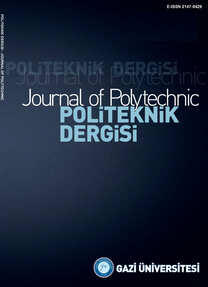Doluluk Oranlarının PLA ve PET Malzemelerin Mekanik Özellikleri Üzerine Etkileri
Doluluk oranı, PET, PLA, pürüzlülük, sertlik
Effects of Filling Percentage on Mechanical Properties of PLA and PET Materials
Infill percentage, PET, PLA, surface roughness, hardness,
___
- [1] Szykiedansa K., Credo W., “Mechanical properties of FDM and SLA low-cost 3-D prints”, Procedia Engineering (The 20th International Conference: Machine Modeling and Simulations, MMS 2015), 136: 257 – 262, (2016).
- [2] Dawoud M., Taha I., Ebeid S.J., “Mechanical behaviour of ABS: An experimental study using FDM and injection moulding techniques”, Journal of Manufacturing Processes, 21: 39–45, (2016).
- [3] Cubric D., Lencova B., Read F.H., Zlamal J., “Comparison of FDM, FEM and BEM for electrostatic charged particle optics”, Nuclear Instruments and Methods in Physics Research A, 427: 357-362, (1996).
- [4] Sood A.K., Ohdar R.K., Mahapatra S.S., “Experimental investigation and empirical modelling of FDM process for compressive strength improvement”, Journal of Advanced Research, 3: 81–90, (2012).
- [5] Jaina P., Kutheb A.M., “Feasibility Study of manufacturing using rapid prototyping: FDM Approach”, Procedia Engineering, 63: 4 – 11, (2013).
- [6] Rauta S., Jattib V.K.S., Nitin K., Khedkar K., Singh T.P., “Investigation of the effect of built orientation on mechanical properties and total cost of FDM parts”, Procedia Materials Science, 6:1625 – 1630, (2014).
- [7] Gurrala P.K., Regalla S.P., DOE Based Parametric Study of Volumetric Change of FDM Parts”, Procedia Materials Science, 6: 354 – 360, (2014).
- [8] Nuñeza P.J., Rivasa A., García-Plazaa E., Beamudb E., Sanz-Loberac A., “Dimensional and surface texture characterization in Fused Deposition Modelling (FDM) with ABS plus”, Procedia Engineering, 32: 856 – 863, (2015).
- [9] Leary M., Kron T., Keller C., Franich R., Lonski P., Subic A., Brandt M., “Additive manufacture of custom radiation dosimetry phantoms: An automated method compatible with commercial polymer 3D printers”, Materials and Design, 86: 487–499, (2015).
- [10] Stephens B., Azimi P., Orch Z.E., Ramos T., “Ultrafine particle emissions from desktop 3D printers”, Atmospheric Environment, 79: 334-339, (2013). [11] Ahrabi A.Z., Bilici İ., Bilgesu A.Y., “Pet Atıkları Kullanılarak Kompozit Malzeme Üretiminin Araştırılması”, Gazi Üniversitesi Mühendislik Mimarlık Fakültesi Dergisi, 27:467-471, (2012).
- [12] Reddy M.M., Vivekanandhan S., Misraa M., Bhatia S.K., Mohantya A.K., “Biobased plastics and bionanocomposites: Current status and future opportunities”, Progress in Polymer Science, 38:1653–1689, (2013).
- [13] Armentano I., Bitinis N., Fortunati E., Mattiolia S., Rescignano N., Verdejo R., Manchado M.A.L., Kenny J.M., “Multifunctional nanostructured PLA materials for packaging and tissue engineering”, Progress in Polymer Science, 38:1720–1747, (2013).
- [14] Raquez J.M., Habibi Y., Murariu M., Dubois P., “Polylactide (PLA)-based nanocomposites”, Progress in Polymer Science, 38:1504–1542, (2013).
- [15] Doğadan gelen doğa dostu biyoplastik hammaddeleri. Bina Dış cepheleri için biyobazlı plastikler [Biodegradable plastics for building exterior] [article in Turkish] http://www.biyoplastik.net/2013/08/bina-ds-cepheleri-icin-biyobazl.html. Accessed January 30, (2018).
- ISSN: 1302-0900
- Yayın Aralığı: 6
- Başlangıç: 1998
- Yayıncı: GAZİ ÜNİVERSİTESİ
Ceren ATİLA DİNÇER, Ali Mert ERDEK, Ayşe KARAKEÇİLİ, Nuray YILDIZ
Odunun Yüzey Pürüzlülüğünün ve Adezyon Direncinin Yapay Sinir Ağları ile Tahmini
A Comparison of Copula Families on Dependence Structure of Extreme Order Statistics
Heterojen Medikal IoT Verilerinin Depolanmasında İlişkisel Olmayan Veritabanına Dayalı Bir Yaklaşım
Doluluk Oranlarının PLA ve PET Malzemelerin Mekanik Özellikleri Üzerine Etkileri
Hatice EVLEN, Merve Ayfer ÖZDEMİR, Aydın ÇALIŞKAN
Combustion Properties of Impregnated and Heat-Treated Wood Material
